
Different Types of Olives
From creating charcuterie boards to garnishing martinis, olives are a versatile ingredient that adds bursts of briny flavor. Each type of olive offers a distinct taste, texture, and culinary use. By familiarizing yourself with the different types, you can elevate your recipes and cater to the diverse tastes of your customers. Whether you're a chef looking to experiment with new flavors or a restaurant owner seeking high-quality olives for your menu, our guide to the most popular olive varieties will help you make an informed decision.
Use the following links to navigate and learn all about olives:
Olives are fruits that fall alongside peaches, apricots, and cherries in the drupe category. Drupes are also known as stone fruits because of the tough, stone-like pits at their centers. The pits found in olives are seeds from the Olea europaea tree, one of the oldest cultivated trees. Due to their long history, a wide variety of olives have been developed. It is estimated that there are over 500 different types of olives grown worldwide.
Olive trees are native to the Mediterranean region, but they're now cultivated worldwide. Approximately 90% of all olives grown globally are used for producing olive oil, while only 10% are designated for table olives. Table olives are cured or brined, resulting in savory and sometimes salty or bitter flavors.
To choose the right type of olives for your application, consider factors such as flavor, texture, and intended use. Some olives are known for their mild, buttery flavor, while others have a robust and tangy taste. Their textures vary from firm and meaty to soft and tender. We provide a list of the 10 most popular olives, the unique characteristics of each type, and their recommended uses and flavor profiles.
1. Kalamata Olives

Originating from Greece, Kalamata olives are an essential ingredient in Mediterranean cuisine and are commonly used in dishes such as Greek salads, moussaka, and pastitsio. They are typically large and almond-shaped, have a deep purple-to-black color, and smooth, shiny skin. Their flesh is meaty and firm.
Kalamata olives have a complex flavor that combines elements of sweetness, saltiness, and tanginess. They are beloved for their robust, fruity flavor that has hints of wine and vinegar. The olives are usually preserved in a brine solution, which enhances their flavor and helps to extend their shelf life.
- Origin: Greece
- Also Called: Calamata, Kalamon, Calamon
- Curing Method: Water or brine
- Characteristics: Cured black. Dark purple skin. Medium size and soft texture. Rich, meaty flavor.
- Applications: Olive oil, salads, pizzas, tapenade
2. Castelvetrano Olives

Castelvetrano olives are a popular variety of olive that originates from the town of Castelvetrano in Sicily, Italy. They are often referred to as Nocellara del Belice olives, in homage to the region where they are grown. Castelvetrano olives offer a mild, buttery flavor profile with hints of sweetness and nuttiness.
Thanks to their early harvest while they're still young and ripening, Castelvetrano olives have a bright green hue. The olives are cured in a brine solution, which helps to preserve their natural color and enhances their flavor. Their comparatively mild flavor and meaty texture add a subtle and satisfying complement to poultry and fish dishes.
- Origin: Castelvetrano, Italy
- Also Called: Nocellara del Belice
- Curing Method: Brine or lye
- Characteristics: Cured green. Large size, tender skin, and firm bite. Mild, nutty, buttery flavor that is favored by those with sensitive palates.
- Applications: Chicken dishes, fish dishes, tapas, charcuterie
3. Nicoise Olives
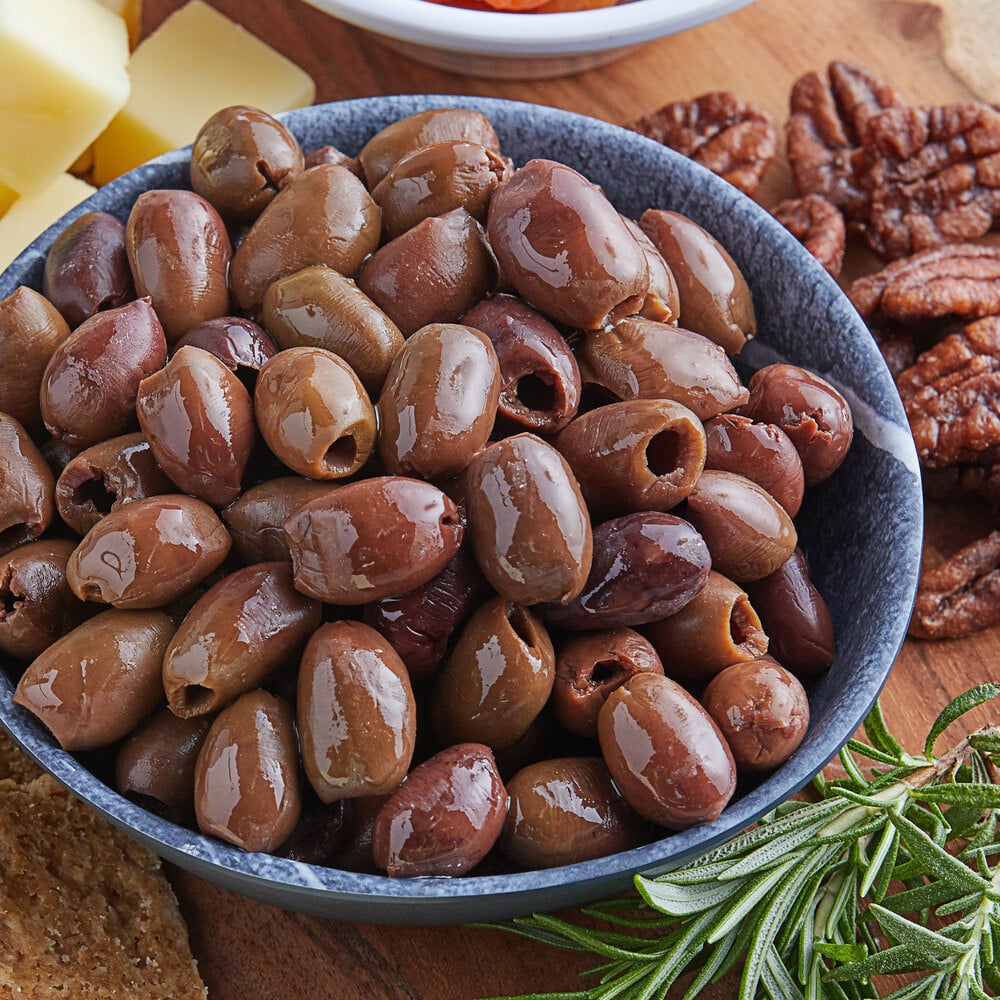
Nicoise olives, also known as olives de Nice, originate from the Nice region of France. They're small in size and have a firm texture. They are typically harvested when they are fully ripe, giving them a rich and intense flavor that is slightly bitter, distinctly earthy, and nutty with a hint of sweetness.
Because they are left on the tree for an extended period to ripen fully, Nicoise olives boast a dark purple to black color. They're common in Mediterranean cuisine, particularly in dishes from the Provence region of France. They are a staple ingredient in the classic French salad, Salade Nicoise.
- Origin: France
- Also Called: Cailletier, Cayet, Taggiasca
- Curing Method: Brine
- Characteristics: Cured black. Small in size. Intensely sour, briny, pleasantly bitter flavor.
- Applications: Salade Nicoise, paired with sheep and goat cheeses, mild and sweet olive oil
4. Manzanilla Olives

Manzanilla olives, also known as Manzanilla de Sevilla, are a popular variety of olives that originate from Spain. These olives are small to medium in size and have a distinct oval shape. They are often harvested when they are still green, giving them a vibrant and attractive appearance. However, they're also used to make canned black olives. Green Manzanilla olives are turned black through oxidation in the curing process.
Manzanilla olives have a slightly bitter taste balanced by a pleasant and tangy flavor. They are commonly used in paella and tapas in Spanish cuisine. They are also a popular choice for garnishing cocktails such as a classic martini or a Bloody Mary.
- Origin: Spain
- Also Called: Manzanillo, Spanish Olive
- Curing Method: Brine or lye
- Characteristics: Often cured green. Varied in size. Plump, firm texture. Briny, slightly bitter flavor.
- Applications: Pitted and stuffed, martinis, tapas, paella
5. Cerignola Olives
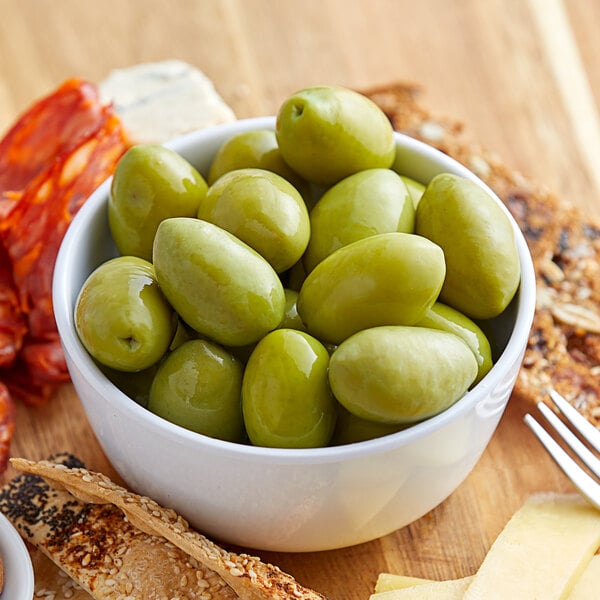
Cerignola olives, also known as Bella di Cerignola olives, are a popular variety that originates from the Puglia region in Southern Italy. They're named after the town of Cerignola, where they have been cultivated for centuries. They are some of the largest olives available in the market, with an average size of about 2-3 centimeters in diameter. Their plump and meaty texture makes them a favorite among olive enthusiasts.
Cerignola olives have a mild and buttery flavor profile, with a hint of sweetness. They are typically harvested at the beginning of the ripening stage when they are still green. This gives them their vibrant green color and firm texture. As they mature, the olives turn a purplish-black color and develop a richer, more intense flavor.
- Origin: Italy
- Also Called: Bella di Cerignola
- Curing Method: Lye
- Characteristics: Cured green, red, and black. Large size. Mild, sweet, buttery flavor. Immature green olives have a firm texture; mature black olives are softer.
- Applications: Stuffed olives, salads, pasta dishes, fish dishes, chicken entrees
6. Gaeta Olives

Gaeta olives originated in the small town of Gaeta, Italy. They have a complex and robust flavor profile with notes of bitterness and saltiness. They're typically small to medium in size and have a firm, meaty texture with slightly wrinkled skin. However, look for plump and shiny Gaeta olives and avoid olives that appear shriveled or dull, because that can indicate poor quality.
Gaeta olives are traditionally cured in a brine solution, which helps to enhance their flavor and preserve their texture. They are commonly used in Mediterranean and Italian cuisine, adding a burst of flavor to salads, pasta dishes, pizzas, and antipasto platters. The intense flavor of Gaeta olives pairs well with other bold ingredients such as garlic, anchovies, and capers.
- Origin: Italy
- Also Called: Gyeta, Itrana
- Curing Method: Salt or brine
- Characteristics: Cured black. Dark purple skin. Small size. Soft texture. Tart, salty flavor.
- Applications: Puttanesca sauce, tapenade, Kalamata olive substitute
7. Picholine Olives
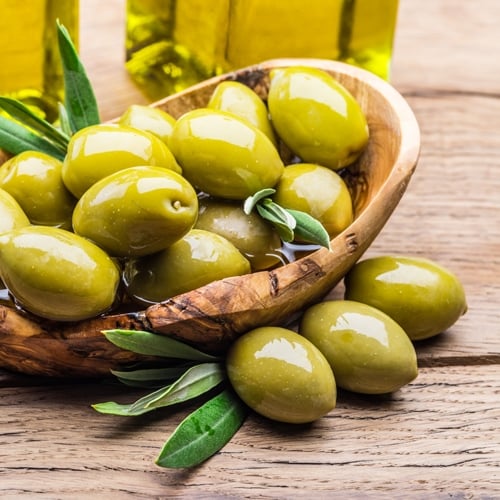
Picholine olives are native to the Mediterranean region where they have been cultivated for centuries. They are typically small to medium in size and have a slightly curved, oblong shape. This unique shape makes them easy to identify and adds an elegant touch to any dish or enhances a trendy charcuterie cone.
Picholine olives have a distinct flavor profile that is both tangy and slightly salty with a subtle fruity undertone, adding a pleasant complexity to their flavor. They are known for their crisp texture and firm flesh, making them ideal for snacking or adding to salads, pasta dishes, or tapenades.
- Origin: France
- Also Called: Colliasse, Fausse Lucques, Piquette
- Curing Method: Brine or lye
- Characteristics: Cured green. Small size, characteristic torpedo shape. Frim, crisp texture. Lemony, briny, buttery flavor.
- Applications: Moroccan olive oil, fish dishes, martinis, charcuterie boards
8. Queen Olives

Queen olives are known for their large size and rich flavor. They're typically harvested when fully ripe, resulting in a sweet and buttery flavor. Since they're larger than other varieties, queen olives are a visually appealing choice for garnishing martinis or serving as a standalone snack. Their size also means that they have a higher flesh-to-pit ratio, making them easier to work with in culinary applications.
Queen olives are commonly used in Mediterranean and Middle Eastern cuisines, where they are a staple ingredient in dishes like tapenades, antipasto platters, and mezze spreads. They can also be stuffed with a variety of fillings, such as cheese, garlic, or peppers, to add an extra layer of flavor.
- Origin: Spain
- Also Called: Sevillano, Gordal
- Curing Method: Lye, brine, or water
- Characteristics: Cured green. Large size. Firm, meaty texture. Briny, nutty flavor.
- Applications: Martini olives, stuffing olive, mezze spreads, tapenades
9. Mission Olives

Mission olives, also known as California black olives, are known for their rich, meaty texture and mild, bright, and grassy flavor. They have a shiny, black skin that adds a visually appealing element to any dish. This color is achieved through a natural curing process that involves brining the olives in a saltwater solution.
Mission olives are typically harvested when they are fully ripe, which gives them their distinct flavor profile. They are typically larger than other varieties, making them great for stuffing or enjoying on their own. They are the most popular type of olive in the United States and are frequently used as a topping on different varieties of pizza.
- Origin: California, United States
- Also Called: California Mission
- Curing Method: Lye, brine, or salt
- Characteristics: Cured black. Small in size. Mild yet peppery flavor.
- Applications: Pizzas, sandwiches, salads, and olive oil
10. Calabrese Olives

Calabrese olives, also known as Calabrian olives, come from the Calabria region in Southern Italy. Their slightly bitter and tangy flavor profile is accented by hints of fruitiness and spiciness. Calabrese olives add depth and complexity to a variety of Italian dishes and are often included in antipasto platters, salads, pasta dishes, and pizza toppings.
Calabrese olives are typically small- to medium-sized and have an oval shape. They have a firm texture and a deep, dark purple color when fully ripened. The olives are harvested at the peak of their flavor and then cured to enhance their taste and texture and remove their natural bitterness.
- Origin: Calabrian region, Southern Italy
- Also Called: Oliva Schiacciate, Calabria
- Curing Method: Brine
- Characteristics: Deep purple to black color. Firm, meaty texture. Slightly bitter flavor balanced by pleasant fruit and nut undertones.
- Applications: Antipasto platters, salads, pasta dishes, and pizzas
It might seem like green and black olives are different types of olives, but actually, an olive's color is an indication of its ripeness. Young, unripe olives have a green to straw-yellow color but as they mature, they will turn from green to red, purple, or brown, before eventually becoming black when they are fully ripe. So, the darker the olive, the more ripe it was when it was picked.

Young, green olives typically have dense, firm flesh, and their flavor can be somewhat bitter. Fully mature black olives have a softer texture and a smoother flavor with less bitterness. Black olives also have a higher oil content than their green counterparts.
Stuffed olives are pitted olive fruits with interiors filled with specialty ingredients. Olives stuffed with pimento peppers are the most popular and widely available type of stuffed olives. From hot peppers and crunchy pickles to flavorful vegetables and varieties of cheese, there are dozens of fillings for you to select from.
Popular stuffed olive fillings include pimento, blue cheese, almond, and garlic. Beyond these common favorites, there's a stuffed olive variety to suit practically any taste. Discover the benefits and flavor profiles of the most popular types of stuffed olives below.

Pimento Stuffed Olives
Red pimento-stuffed olives are the most popular type of stuffed olive. The combination of the smooth, briny olive and the crunchy red pimento pepper creates a delightful contrast in both visual appeal and texture. Pimento-stuffed olives are commonly used as a garnish for cocktails, such as martinis and Bloody Marys. Additionally, these olives can be sliced and added to salads, antipasto platters, or sandwiches to provide a tangy and savory element.

Blue Cheese Stuffed Olives
Blue cheese-stuffed olives are a popular martini garnish that adds a unique twist to your favorite cocktail. The funky, tangy flavor of blue cheese is a great complement to the briny, savory taste of olives. The richness of the cheese enhances the overall flavor profile of the olive, creating a delightful balance of saltiness and creaminess. Blue cheese-stuffed olives are not only a delicious addition to martinis, but they can be added to salads and pasta dishes or served as an appetizer alongside other cheese and charcuterie.
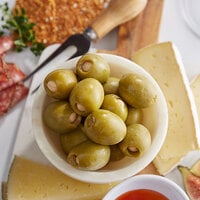
Almond Stuffed Olives
Whether you're serving hors d'oeuvres at a fancy event or looking for tasty tapas, almond-stuffed olives are a delightful addition to any menu. The pairing of crunchy, buttery almonds with smooth, briny olives creates a delightful contrast that will please your customers. The almonds add a satisfying crunch and a rich, nutty flavor that complements the savory taste of the olives. One of the advantages of almond-stuffed olives is their versatility. They can be enjoyed on their own as a standalone appetizer or incorporated into a variety of dishes.
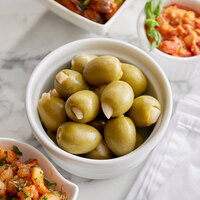
Garlic Stuffed Olives
Garlic-stuffed olives offer a delightful combination of pungent garlic and salty olives, creating a unique taste that is loved by many. They are a popular choice for those looking to add a burst of flavor to their charcuterie boards or appetizer platters. They pair exceptionally well with mild cheeses like burrata and feta. The pungency of the garlic complements the creaminess of these cheeses, creating a harmonious flavor profile. Adding garlic-stuffed olives to a cheese board not only enhances the taste but also adds an attractive visual element to the presentation.
While there are many types of pre-stuffed olives available for you to purchase, you can also stuff your own olives to fully customize the flavor and texture of the final product.
- Start with Pitted Olives: Any large variety of pitted olives will do, though green olives are most commonly used.
- Creamy Stuffings: To stuff olives with creamy ingredients like blue cheese, cream cheese, or goat cheese, add the filling to a pastry bag fitted with a small round tip and pipe the mixture directly into the center of the olives.
- Firm Stuffings: To stuff olives with firm ingredients like almonds, pickles, or cocktail onions, cut the stuffing to size if necessary, then insert directly into the olive.
What Are Pitted Olives?
Pitted olives have had their pits or stones removed, making them ready to eat or stuff straight out of the jar. One of the main advantages of pitted olives is the time and effort they save in food preparation.
Back to TopRelated Resources

Types of Cheese
Cheese, a widely cherished ingredient in the culinary world, has a rich history and is an integral part of almost every cuisine worldwide. Different types of cheese are made from varying milk, methods, and aging times and processes. Cheese is used in thousands of different applications, from sophisticated charcuterie boards to simple sandwiches. Shop All Cheese Click the following links to navigate to each type of cheese: Blue Cheese Fresh Cheese Soft Cheese Semi-Soft Cheese Semi-Firm Cheese Hard Cheese

What Is Charcuterie?
Why does everyone love charcuterie boards? Besides the artful presentation that photographs so well on social media, charcuterie brings together all your favorite finger foods in one place. What used to be called a fancy "meat and cheese board" is now a star of tapas menus . Charcuterie boards are no longer a passing food trend and have become a culinary staple for gatherings, catered events, and restaurant menus. If you're still wondering how you should say this French term, it's pronounced shahr-KOO-tuh-ree . Learn a little bit more about the tradition of charcuterie or get started with making your own board . Click below to learn more about charcuterie boards: How to Make a Charcuterie Board Charcuterie Cheeses Charcuterie Meats Charcute

Types of Pizza
Since its humble beginnings in Italy, pizza has gone through numerous transformations to become the dish that so many people know and love today. But if you're just opening your first pizza place or want to add a pizza oven to your restaurant's patio , it can be difficult to decide what style of pizza your restaurant will make. We discuss the different types of pizza, their history, and what you'll need to make them so you can start serving up delicious slices to your guests. Shop All Pizza Supplies and Equipment Use these links to learn more about the different types of pizza: Neapolitan Pizza Chicago Pizza New York Pizza Sicilian Pizza Greek Pizza California Pizza Detroit Pizza St. Louis Pizza Types of Pizza Crust Pizza Styles Check out o
- Topics 1346
- Industrial 55
- Troubleshooting Guides 21
- Restaurant Management 128
- Bar Management 55
- Catering Tips 35
- Bakery Management 42
- Food Trucks & Concessions 49
- Advertising & Marketing 37
- Eco-Friendly Tips 11
- Facility Layout & Design 41
- Coffee Shop Tips 28
- Installation & Maintenance 51
- Janitorial & Pest Control 30
- Safety & Sanitation 88
- Startup Tips 104
- Menu Design 10
- Kitchen & Cooking Tips 81
- Hospitality Management 23
- Pizza & Sandwich Shop Tips 36
- Smallwares 37
- Food Prep 88
- Tabletop Items 17
- Disposables 22
- Calculators & Tools 6
- Consumables 52
- Warewashing & Laundry 18
- Cooking Equipment 90
- Food Storage & Refrigeration 51
- Beverage Equipment 34
- Office Supplies 6
- Resource Type
- In-Depth Articles272
- Buying Guides296
- How-Tos93
- Product Reviews77


